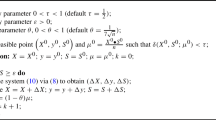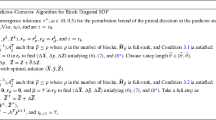Abstract
Many theoretical and algorithmic results in semidefinite programming are based on the assumption that Slater's constraint qualification is satisfied for the primal and the associated dual problem. We consider semidefinite problems with zero duality gap for which Slater's condition fails for at least one of the primal and dual problem. We propose a numerically reasonable way of dealing with such semidefinite programs. The new method is based on a standard search direction with damped Newton steps towards primal and dual feasibility.
Similar content being viewed by others
References
F. Alizadeh, “Interior point methods in semidefinite programming with applications to combinatorial optimization,” SIAM Journal on Optimization, vol. 5, no. 1, pp. 13–51, 1995.
F. Alizadeh, J-P.A. Haeberly, and M.L. Overton, “Primal-dual interior-point methods for semidefinite programming: Convergence rates, stability and numerical results,” SIAM Journal on Optimization, vol. 8, no. 3, pp. 746–768, 1998.
A. Ben-Israel, A. Charnes, and K. Kortanek, “Duality and asymptotic solvability over cones,” Bulletin of American Mathematical Society, vol. 75, no. 2, pp. 318–324, 1969.
E. de Klerk, C. Roos, and T. Terlaky, “Infeasible-start semidefinite programming algorithms via self-dual embeddings,” in Topics in Semidefinite and Interior-Point Methods. vol. 18: The Fields Institute for Research in Mathematical Sciences, Communications Series, Providence, Rhode Island, 1998. American Mathematical Society, pp. 215–236.
M.X. Goemans and D.P. Williamson, “.878-approximation algorithms for MAX CUT and MAX 2SAT,” in Proceedings of the Twenty-Sixth Annual ACM Symposium on the Theory of Computing, pages 422–431, Montréal, Québec, Canada, 1994, pp. 422–431.
M.X. Goemans and D.P. Williamson, “Improved approximation algorithms for maximum cut and satisfiability problems using semidefinite programming,” Journal of the ACM, vol. 42, no. 6, pp. 1115–1145, 1995. preliminary version, see [5].
G. Gruber, “On Semidefinite Programming and Applications in Combinatorial Optimization,” PhD Thesis, University of Technology, Graz, Austria, 2000. Shaker Verlag: Aachen—Maastricht, ISBN 3-8265-7541-5.
C. Helmberg, F. Rendl, R.J. Vanderbei, and H. Wolkowicz, “An interior point method for semidefinite programming,” SIAM Journal on Optimization, vol. 6, no. 2, pp. 342–361, 1996.
S.E. Karisch and F. Rendl, “Semidefinite programming and graph equipartition,” in Topics in Semidefinite and Interior-Point Methods. vol. 18: The Fields Institute for Research in Mathematical Sciences, Communications Series, Providence, Rhode Island, 1998. American Mathematical Society, pp. 77–95.
M. Kojima, S. Shindoh, and S. Hara, “Interior point methods for the monotone linear complementarity problem in symmetric matrices,” SIAM Journal on Optimization, vol. 7, no. 1, pp. 86–125, 1997.
R.D.C. Monteiro, “Primal-dual path-following algorithms for semidefinite programming,” SIAM Journal on Optimization, vol. 7, no. 3, pp. 636–678, 1997.
Yu. E. Nesterov and A.S. Nemirovskii, Interior Point Polynomial Algorithms in Convex Programming, SIAM Publications: SIAM, Philadelphia, USA, 1994.
Yu.E. Nesterov and M.J. Todd, “Primal-dual interior-point methods for self-scaled cones,” SIAM Journal on Optimization, vol. 8, no. 2, pp. 324–364, 1998.
F. Rendl, “Semidefinite programming and combinatorial optimization,” Applied Numerical Mathematics, vol. 29, pp. 255–281, 1999.
J.F. Sturm, “Using SeDuMi 1.02, a MATLAB toolbox for optimization over symmetric cones,” Optimization Methods and Software, vol. 11, pp. 625–653, 1999.
K.C. Toh, M.J. Todd, and R. Tutuncu, “SDPT3—a matlab software package for semidefinite programming,” Optimization Methods and Software, vol. 11, pp. 545–581, 1999.
L. Vandenberghe and S. Boyd, “Semidefinite programming,” SIAM Review, vol. 38, no. 1, pp. 49–95, 1996.
S.J. Wright, Primal-Dual Interior-Point Methods, Society for Industrial and Applied Mathematics: 3600 University City Science Center, Philadelphia, 1997.
Q. Zhao, S.E. Karisch, F. Rendl, and H. Wolkowicz, “Semidefinite programming relaxations for the quadratic assignment problem,” Journal of Combinatorial Optimization, vol. 2, no. 1, pp. 71–109, 1998.
Author information
Authors and Affiliations
Rights and permissions
About this article
Cite this article
Gruber, G., Rendl, F. Computational Experience with Ill-Posed Problems in Semidefinite Programming. Computational Optimization and Applications 21, 201–212 (2002). https://doi.org/10.1023/A:1013716917710
Issue Date:
DOI: https://doi.org/10.1023/A:1013716917710




